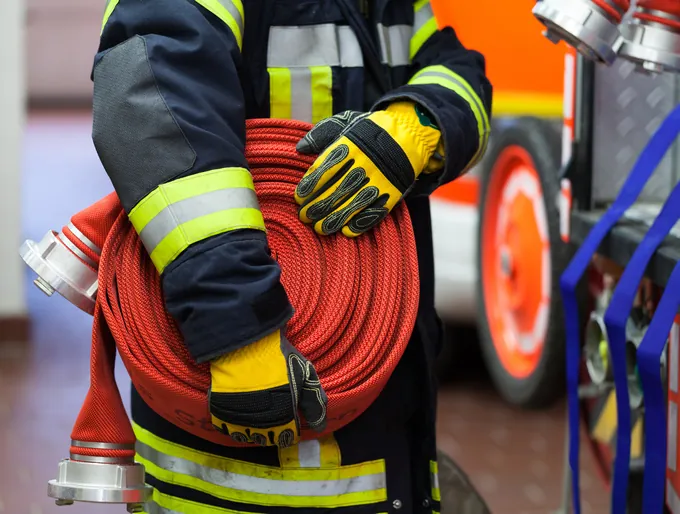Raleigh, NC: (919) 277-9299

Steven started at the firehouse at 18 and has embraced the culture wholeheartedly, even after AFFF toxins and contaminated firefighter gear nearly took his life. The diagnosis was thyroid cancer, a disease linked to the per- and polyfluoroalkyl substances (PFAS) in firefighting foam. Though this family man didn’t know what these chemicals were, he quickly learned how the contaminants affected his health. Steven went from combating fires to battling for his life with almost no warning.
The cancer required one surgery after another and medical bills piled up as Steven’s absence from work continued. Even after the immediate threat had subsided, the financial burden led to countless stressful, sleepless nights. Steven had no choice but to return to the only job he had ever known, hopeful that this time around his occupational exposure to toxic chemicals wouldn’t end in tragedy.
Shifting Staples of Firehouse Culture
Fire departments are known for traditions for welcoming recruits, mealtimes, and various other rituals. A 23-year veteran fire chief, Greg, explained that clean gear meant you didn’t work hard enough. Countless firefighters lived by the rule that the dirtier your gear, the harder you worked.
Unfortunately, the firehouse culture that measured hard work by the condition of one’s suit led to an increase in exposure to AFFF and toxic PFAS chemicals. As awareness of suppressant hazards spread, so did the calls for improved safety practices. Fire departments have begun changing their long-standing traditions and adjusting firefighting foam training and tactics to prioritize health, safety, and transparency.
Exchanging ‘Rites of Passage’ for Firefighters’ Rights
Initiations have long been part of the firehouse culture, and AFFF was often used in rites of passage to welcome newbies. Stories abound of rookies doused in ‘foam showers’ and blanketed during firefighting training exercises as they learned to handle the suppressants. The manufacturers of AFFF offered no health warnings or advisories for cleanup methods, and fire stations had loads of the concentrate on hand, so these traditions seemed harmless. Even the fire trucks were shined with the concentrate because PFAS chemicals in firefighting foam were lauded for their degreasing capabilities.
Crews who once accepted fire station culture without question are now asking for solutions to reduce chemical exposures from firefighter gear and training. After losing countless colleagues to diseases related to PFAS chemicals in firefighting foam and equipment, firefighters are establishing new traditions—like the right to work and live in a non-toxic environment and the right to choose safe firefighting foam alternatives for training and suppression.
Redefining Strength in Firehouse Culture
While first responders with the dirtiest gear and brawniest attitudes were held in the highest esteem in firehouses for years, these men and women are no longer considered the strongest of the bunch. Today, strength means fighting illnesses that appear out of nowhere and losing people you’ve spent a career working alongside to cancer and debilitating diseases. Steven’s toughness shows every day that he suits up in gear contaminated with PFAS chemicals to work a job that nearly cost him his life.
The firehouse culture that prizes strength hasn’t changed, but firefighters’ definitions of ‘tough’ certainly have. Those battling cancer and other diseases from AFFF exposure now reign as the industry’s strongest members.
Steering Firefighters’ Slogans Toward Safety
“Hit it hard from the yard,” once dominated the war cries of firehouse culture, but the messages behind the slogans that firefighters rely on have shifted towards health and safety. One of the latest is, “Shower within the hour,” a reminder to wash the PFAS chemicals in firefighting foam and other contaminants off after returning from a tour. Another is, “Prohibit PPE,” to keep turnout pants and other contaminated firefighter gear away from living areas. Though the term ‘bunker gear’ was given to turnout suits and boots because it was stored within easy reach of firefighters’ beds, this practice has been overhauled at fire stations that now require protective equipment to be isolated.
Making Awareness a Priority
Clubhouse traditions weren’t the only reasons firefighters were stepping into smoked-scarred, chemical-saturated suits. Most firefighters weren’t aware that contaminated firefighter gear could increase their risk of serious diseases, nor that the suppressants they were using were laced with PFAS chemicals. The manufacturers of aqueous foam suppressants hid the case studies citing the dangers, and after the formulas changed from C8 to C6, many of these producers made inflated safety claims about the new concentrates. These failings have led firehouses to make awareness of AFFF hazards and safety issues part of their culture.
The crisis caused by AFFF has irreversibly changed firehouse culture. It’s time for manufacturers to ditch their traditions of valuing profits over people’s health and adopt cultures built on safety and transparency. Advocates for firefighters hope the multidistrict litigation is the push these manufacturers need.
Learn more about Steve and health concerns about AFFF in firefighter gear.
